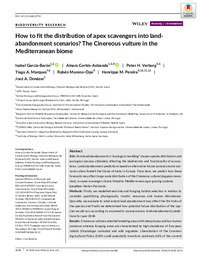Por favor, use este identificador para citar o enlazar este ítem:
https://hdl.handle.net/11000/6001Registro completo de metadatos
| Campo DC | Valor | Lengua/Idioma |
|---|---|---|
| dc.contributor.author | García Barón, Isabel | - |
| dc.contributor.author | Cortés Avizanda, Ainara | - |
| dc.contributor.author | Verburg, Peter H. | - |
| dc.contributor.author | Marques, Tiago A. | - |
| dc.contributor.author | Moreno Opo, Rubén | - |
| dc.contributor.author | Pereira, Henrique M. | - |
| dc.contributor.author | Donázar, José A. | - |
| dc.contributor.other | Departamentos de la UMH::Biología Aplicada | es |
| dc.date.accessioned | 2020-05-08T08:23:00Z | - |
| dc.date.available | 2020-05-08T08:23:00Z | - |
| dc.date.created | 2018-06-16 | - |
| dc.date.issued | 2020-05-08 | - |
| dc.identifier.issn | 1366-7209 | - |
| dc.identifier.issn | 1472-4642 | - |
| dc.identifier.uri | http://hdl.handle.net/11000/6001 | - |
| dc.description.abstract | Aim Farmland abandonment or “ecological rewilding” shapes species distribution and ecological process ultimately affecting the biodiversity and functionality of ecosystems. Land abandonment predictions based on alternative future socioeconomic scenarios allow foretell the future of biota in Europe. From here, we predict how these forecasts may affect large‐scale distribution of the Cinereous vulture (Aegypius monachus), an apex scavenger closely linked to Mediterranean agro‐grazing systems. Location Iberian Peninsula. Methods Firstly, we modelled nest‐site and foraging habitat selection in relation to variables quantifying physiography, trophic resources and human disturbance. Secondly, we evaluate to what extent land abandonment may affect the life traits of the species and finally we determined how potential future distribution of the species would vary according to asymmetric socioeconomic land‐abandonment predictions for year 2040. Results Cinereous vultures selected breeding areas with steep slopes and low human presence whereas foraging areas are characterized by high abundance of European rabbits (Oryctolagus cuniculus) and wild ungulates. Liberalization of the Common Agricultural Policy (CAP) could potentially transform positively 66% of the current nesting habitat, favouring the recovery of mature forest. Contrarily, land abandonment would negatively affect the 63% of the current foraging habitat reducing the availability of preferred food resources (wild European rabbit). On the other hand, the maintenance of the CAP would determine lower frequencies (24%–22%) of nesting and foraging habitat change. Main conclusions Land abandonment may result into opposite effects on the focal species because of the increase in nesting habitats and wild ungulates populations and, on the other hand, lower availability of open areas with poorer densities of European rabbits. Land‐abandonment models’ scenarios are still coarse‐grained; the apparition of new human uses in natural areas may take place at small‐sized and medium‐sized scales, ultimately adding complexity to the prediction on the future of biota and ecosystems. | es |
| dc.description.sponsorship | Spanish Ministry of Economy and Competitiveness, Grant/Award Number: BES-2014-070597 | - |
| dc.description.sponsorship | Juan de la Cierva Incorporación, Grant/Award Number: IJCI-2014-20744; | - |
| dc.description.sponsorship | Programa Viçent Mut of Govern Balear, Spain, Grant/Award Number: PD/039/2017; | - |
| dc.description.sponsorship | Consejería de Innovación, Ciencia y Empleo, Junta de Andalucía, Grant/Award Number: RNM-1925; | - |
| dc.description.sponsorship | MINECO/FEDER EU, Grant/Award Number: CGL2015-66966-C2-1-2-R; | - |
| dc.description.sponsorship | Severo Ochoa Excellence Award from the Spanish Ministry of Economy and Competitiveness, Grant/Award Number: SEV-2012-0262; | - |
| dc.description.sponsorship | CEAUL; FCT—Fundação para a Ciência e a Tecnologia, Portugal, Grant/Award Number: UID/MAT/00006/2013 | - |
| dc.format | application/pdf | es |
| dc.format.extent | 14 | es |
| dc.language.iso | eng | es |
| dc.rights | info:eu-repo/semantics/openAccess | es |
| dc.subject | Aegypius monachus | es |
| dc.subject | logical rewilding | es |
| dc.subject | European Union | es |
| dc.subject | farmland | es |
| dc.subject | land abandonment | es |
| dc.subject | socioeconomies | es |
| dc.subject.other | 573 - Biología general y teórica | es |
| dc.title | How to fit the distribution of apex scavengers into land-abandonment scenarios? The Cinereous vulture in the Mediterranean biome | es |
| dc.type | info:eu-repo/semantics/article | es |
| dc.identifier.doi | DOI: 10.1111/ddi.12743 | - |
| dc.relation.publisherversion | https://doi.org/ DOI: 10.1111/ddi.12743 | - |

Ver/Abrir:
6-García-Barón et al 2018 Diversity and Distributions.pdf
2,6 MB
Adobe PDF
Compartir:
 La licencia se describe como: Atribución-NonComercial-NoDerivada 4.0 Internacional.
La licencia se describe como: Atribución-NonComercial-NoDerivada 4.0 Internacional.
.png)